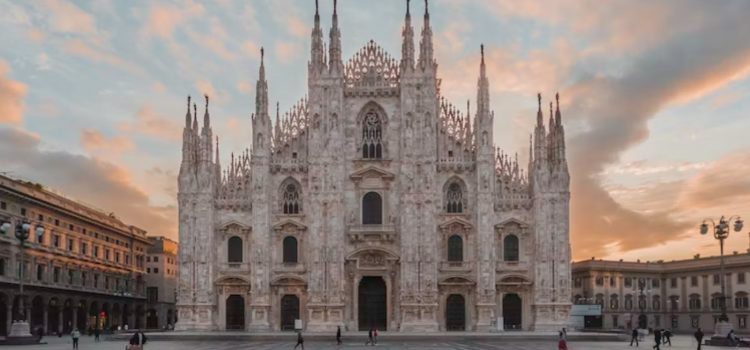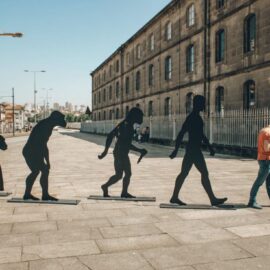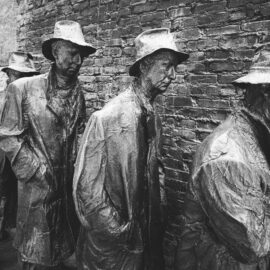

This article is an excerpt from the Shortform book guide to "Leonardo da Vinci" by Walter Isaacson. Shortform has the world's best summaries and analyses of books you should be reading.
Like this article? Sign up for a free trial here.
What did Leonardo da Vinci do in Milan? Why did Leonardo prefer Milan over Florence?
Throughout his life, Leonardo da Vinci spent most of his time in Italy. He lived in Milan twice in his life, where he was able to commission his art and express himself as an artist.
Learn more about Leonardo da Vinci’s Milan accomplishments and adventures below.
Milan (1482-1499)
Lorenzo de’ Medici sent Leonardo da Vinci to Milan as a diplomatic envoy, opening a new chapter in Leonardo’s life. Lorenzo often leveraged Florence’s cultural capital in his diplomatic relations with the other Italian city-states. On this occasion, Isaacson argues that Lorenzo leveraged Leonardo’s skills as a gift to the Duke of Milan, Ludovico Sforza.
In the biography Leonardo da Vinci, Walter Isaacson explains that Milan offered Leonardo many advantages. First, it was larger than Florence but it didn’t have as many accomplished artists, so he would have less competition. Second, Milan’s duke was filling his court with artists, engineers, and philosophers, so Leonardo had a source of employment and the opportunity to collaborate with other intellectuals.
A New Patron: Duke Ludovico Sforza
Once in Milan, Leonardo applied for a job at the Duke’s court. Isaacson claims that Leonardo emphatically promoted his ability to design weapons and war mechanisms. He did this because, first, he knew the Duke would be interested in strengthening his military power, and second, he was going through a painting rough patch and was feeling frustrated with his lack of accomplishments. However, the only military project Leonardo ever carried out for the Duke was a survey of the castle’s defenses.
Leonardo eventually secured his entry into Ludovico’s court as a producer of plays, pageants, and social events. According to Isaacson, these events legitimized Ludovico’s power, kept his people distracted, and kept family members with claims to power busy. On his part, Leonardo finally achieved the recognition he craved and could support himself by exercising his creativity and multidisciplinary approach through the combination of art and engineering.
Unfortunately, Ludovico was an unreliable employer and Leonardo began searching for other opportunities in the late 1490s, even going so far as to write letters in the third person praising his own work to possible patrons. In 1499, the French army invaded Milan and Ludovico fled. Leonardo remained in Milan for a few months, but in 1500, he decided to return to Florence.
Leonardo’s Chosen Family: Salai
In 1490, while living in Milan, 10-year-old Gian Giacomo Caprotti da Oreno, nicknamed Salai (meaning little devil), moved in with Leonardo. According to Isaacson, he was Leonardo’s apprentice, the companion and possible sexual partner who stayed with him the longest, and the inspiration for many of Leonardo’s drawings. Gian earned his nickname through acts of mischief—Leonardo’s notebooks include five references to Salai stealing from him and to fights they had where Leonardo let the boy have his way.
Milan, Again (1506-1513)
In 1506, Leonardo returned to Milan to resolve a dispute over a painting, but he stayed there after resolving it. Isaacson argues that he stayed because he had no interest in returning to Florence and the visibility he had there as an artist. To appease the Florentine government, Leonardo asked the French rulers of Milan to intervene on his behalf so he could stay in Milan. Compared to Florence, Milan was a vibrant city that offered Leonardo more opportunities, and Isaacson claims he stood out less than in small-town Florence. In Milan, he also had the favor of the King of France and the French governor of Milan.
(Shortform note: Leonardo’s preference for Milan is repaid by how the city treasures his legacy. In 1872, the city built a statue of Leonardo with a flowing beard and contemplative brow. Some blocks away, a sculptural rendition of Leonardo’s maps of Milan sits in the middle of the old city.)
A New Patron: Charles d’Amboise
The French governor of Milan, Charles d’Amboise, became Leonardo’s patron. Isaacson claims that Leonardo became the most important member of Charles’s court in Milan. Charles wanted to surround himself with artists, engineers, and scientists—and Leonardo was all those things in one man. Charles gave Leonardo a salary and a home to live in, along with Salai. He was also protective of Leonardo. For example, when the Florentine government demanded that Leonardo return to finish some commissions he abandoned, Charles chastised them for badgering Leonardo and told them to take better care of their city’s most accomplished son. Until his death in 1511, Charles was a kind patron to Leonardo.
Leonardo’s Chosen Family: Francesco Melzi
In 1507, Leonardo adopted 14-year-old Francesco Melzi. Isaacson explains that, although Francesco had living parents who could support him, his family saw the adoption as a way to ensure a successful career as an artist. After Charles d’Amboise died in 1511, Leonardo moved into the Melzi family villa until he could find new employment.

———End of Preview———
Like what you just read? Read the rest of the world's best book summary and analysis of Walter Isaacson's "Leonardo da Vinci" at Shortform.
Here's what you'll find in our full Leonardo da Vinci summary:
- A detailed look into the life, accomplishments, and struggles of Leonardo da Vinci
- Lessons from his life and work that you can apply to your own life
- What set Leonardo apart from other artists at the time






